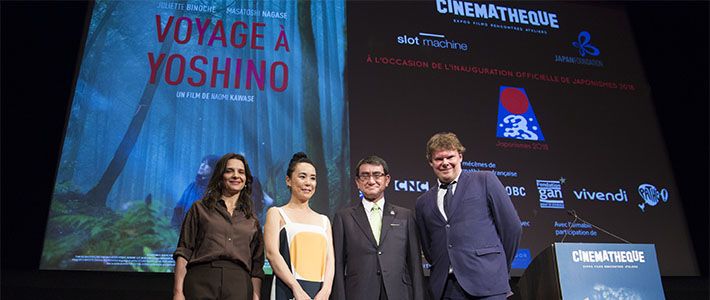
“Japonismes 2018”: Paris Enthralled by Japanese Films
Culture- English
- 日本語
- 简体字
- 繁體字
- Français
- Español
- العربية
- Русский
“Japonismes 2018: les âmes en resonance” is an eight-month celebration of Japanese culture launched in France on July 12 in commemoration of 160 years of friendship between Japan and France. The event was born of an agreement made two years ago between Prime Minister Abe Shinzō and François Hollande, president of France at the time, and was brought to fruition under the current president of France, Emmanuel Macron. The program—comprising exhibitions, stage performances, films, and cultural exchange events with themes taken from everyday Japanese life—is spread out over 100 locations, most of which are in or near Paris.
From September through March next year, the Cinémathèque Française film archive and the Maison de la culture du Japon, both in Paris, will be showing retrospectives of Japanese films spanning three major periods of Japanese cinematography, from the 1920s to the present. The retrospective was kicked off with a showing of the 2018 film Vision at the Cinémathèque Française. The opening event was attended by Vision director Kawase Naomi; Japan’s Minister for Foreign Affairs Kōno Tarō, representing Prime Minister Abe whose trip was cancelled due to the heavy rains of western Japan; and Kitaoka Atsushi, mayor of Yoshino, the town in Nara Prefecture where the film was made.
A Tribute to the Natural Beauty of Yoshino
Prior to the showing of the film, the audience was enthralled by the dramatic appearance on stage of yamabushi mountain ascetics blowing conch shells. Following this performance, Gojō Ryōchi, head priest of the Yoshino temple Kinpusen-ji, introduced the film Vision as an expression of the Japanese people’s love, respect, and reverence for nature in its setting of the mountains of Yoshino. He was followed by Kawase, who was enthusiastically welcomed with loud applause from the audience.
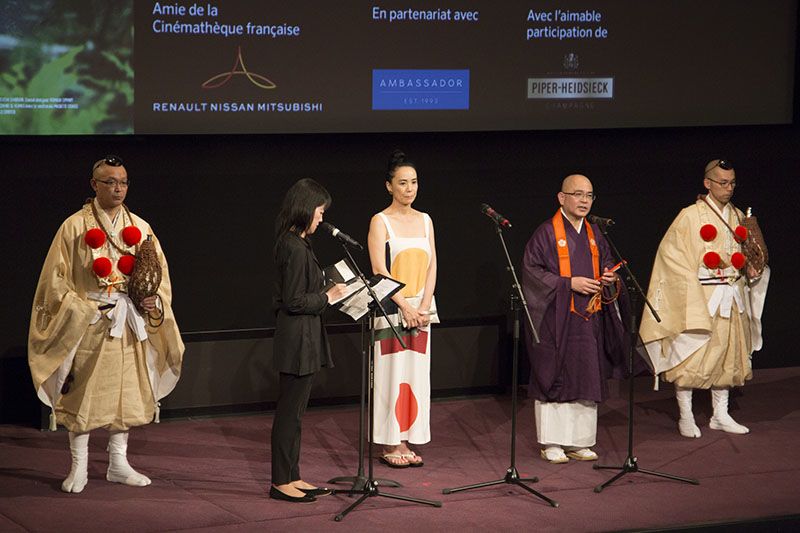 Vision director Kawase Naomi (center) listens as Gojō Ryōchi, head priest of Kinpusen-ji in Yoshino, Nara Prefecture, speaks of the ascetic yamabushi tradition.
Vision director Kawase Naomi (center) listens as Gojō Ryōchi, head priest of Kinpusen-ji in Yoshino, Nara Prefecture, speaks of the ascetic yamabushi tradition.
“My films portray people co-existing with nature,” said Kawase. “In Japan, many lives have been lost in natural disasters, most notably the 2011 Great East Japan earthquake, but even now in the torrential rains of western Japan. You may ask: why do we continue to live in areas that are prone to such disasters? The answer is, I believe, to be found in our deeply held conviction passed down from our ancestors that we live by the grace of others and that all life is important. This conviction is what has led me to explore the pathways we humans may tread from here. I think it was fate that guided me to film Vision in the Yoshino mountains and I am most grateful I had that opportunity.”
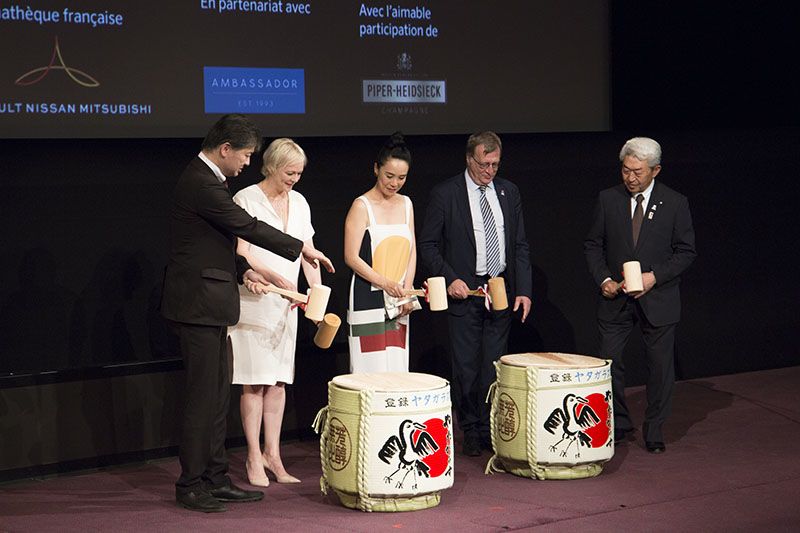 The main guests prepare to break open sake casks to mark the auspicious start of the event. Local products of Nara Prefecture were displayed in the lobby on this day as well.
The main guests prepare to break open sake casks to mark the auspicious start of the event. Local products of Nara Prefecture were displayed in the lobby on this day as well.
Kawase Naomi wrote the script for Vision herself. Filmed in Yoshino, Nara Prefecture, the film stars the popular French actress Juliette Binoche and her male lead, the Japanese actor Nagase Masatoshi. Binoche plays a French essayist named Jeanne who journeys into the forests of Yoshino to search for a plant called “Vision” that is said to appear only once every 1,000 years. She finds herself drawn to Tomo (Nagase), a forest ranger living in the mountains. There is a gradual change in the mountain atmosphere, a change foretold by Tomo’s friend, a blind woman named Aki (Natsuki Mari), when one day Tomo comes across a young man (Iwata Takanori) who has collapsed in the forest.
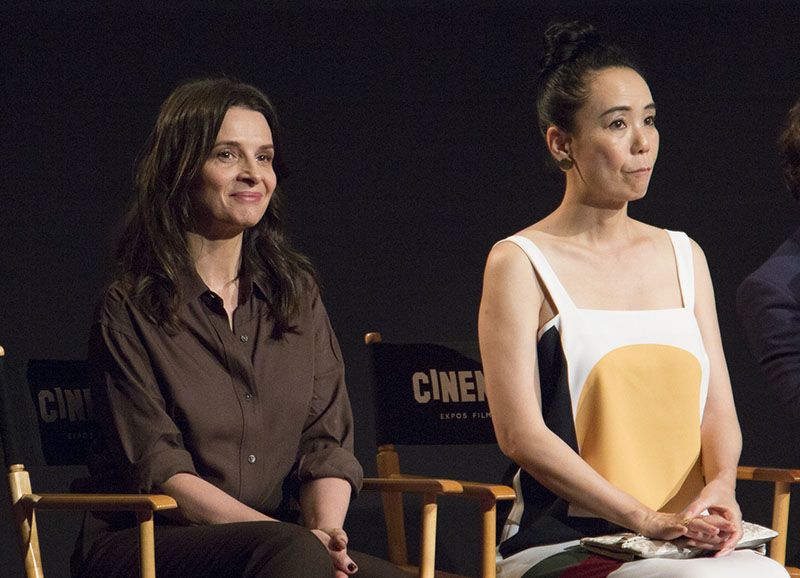 Juliette Binoche (left) and Kawase Naomi.
Juliette Binoche (left) and Kawase Naomi.
Before the screening, Kawase and Binoche spoke about the making of the film.
“The first time we took Juliette to the Yoshino mountains we passed through a tunnel, and when she saw the green mountains before her, she kept exclaiming over and over how beautiful they were. Her appreciation of the scenery helped us to create a truly beautiful film,” said Kawase.
“It is true,” responded Binoche. “I was overwhelmed by Nara and the Yoshino forests. And I was able to experience that world, its customs and traditions, first-hand. I was also impressed by the work of Kawase and her crew. She is a very independent woman and has her own way of doing things. In particular, the moment of silence she required before the cameras rolled was almost sacred. It is something I will long remember along with the sight of the Yoshino forests.”
Binoche continued: “I urge the people of France to go to Japan to see for themselves these mountains and their forests. You will find ancient trees a hundred, even a thousand, years old. I am sure you will fall in love with the wonderful beauty.”
As Binoche suggests, Vision is a spiritual film, and its fablelike story and beautiful cinematography heighten its mysterious air. Some in the audience appeared to have been confused by the film’s refusal to explain mysterious episodes—not to mention the overlapping of the Japanese male characters, who may have been hard to distinguish for a French audience unfamiliar with the different actors—but many still enthused over the beautiful filming of nature, saying the film made them giddy and that they felt as if they had walked in the Yoshino forests themselves.
Japanese Films and France
As the term “Japonismes” suggests, France has long shown a deep appreciation for Japanese culture, and Japanese films have been no exception. As early as 1954, the Cannes Film Festival awarded its grand prize (there was no Palme D’or prize at the time) to Jigokumon (Gates of Hell), a film directed by Kinugasa Teinosuke.
In 1963, Henri Langlois, cofounder of the Cinémathèque Française, held the first screening of Japanese films in France, introducing 140 works by such Japanese directors as Ozu Yasujirō, Mizoguchi Kenji, Naruse Mikio, and Kurosawa Akira. Again, in 1971, a special showing of Japanese films was held to commemorate the 75 years since the first screening of a Japanese-made film in Japan. In 1984, a major retrospective was held introducing as many as 500 Japanese films. Says Frédéric Bonnaud, the current director of the Cinémathèque Française, “Japonismes 2018 continues this long tradition and will further strengthen the ties between Japan and France.”
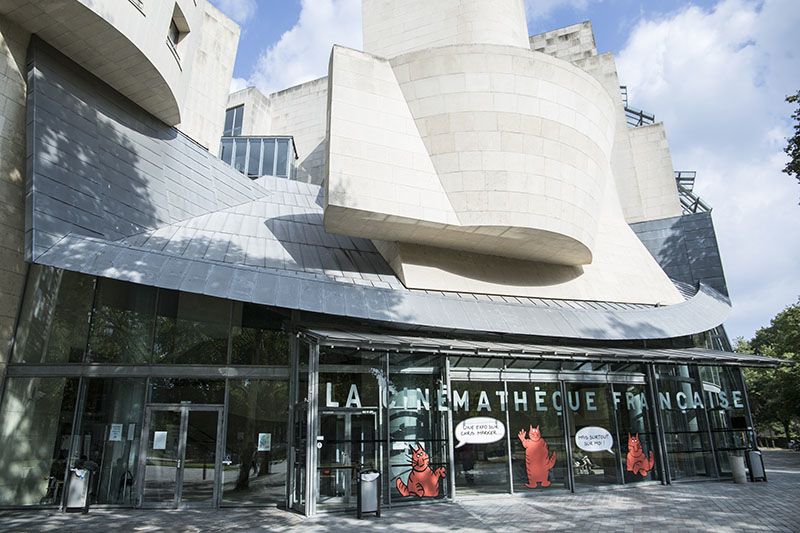 The Cinémathèque Française in Paris’ 12th arrondissement.
The Cinémathèque Française in Paris’ 12th arrondissement.
Since the 1990s, attention has focused on the films of such up-and-coming Japanese directors as Koreeda Hirokazu, Kurosawa Kiyoshi, Aoyama Shinji, and Kawase Naomi. Kawase has captured the attention of the French people since her debut, when she won the Caméra d’Or (best new film) award at the 1997 Cannes Film Festival for Moe no Suzaku (Suzaku), her first feature film. Her position as one of Japan’s first female film directors to appear on the international stage has also attracted attention.
Vision will be shown in French movie theaters from November 28 under the name Voyage à Yoshino (Journey to Yoshino), but before that, on November 23, a joint showing of all the works of Kawase Naomi and Spanish film director Isaki Lacuesta will be shown at the Centre Pompidou.
(Originally published in Japanese on August 17, 2018. Photos © Shimmura Mari. Banner photo: Juliette Binoche, Vision director Kawase Naomi, Japanese Minister for Foreign Affairs Kōno Tarō, and Cinémathèque Française Director Frédéric Bonnaud at the July 12 kick-off event for the film division of Japonismes 2018.)